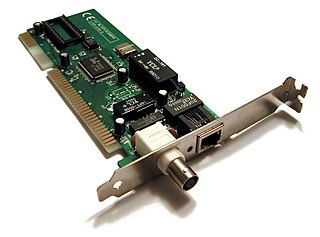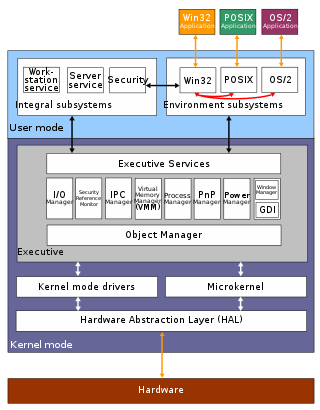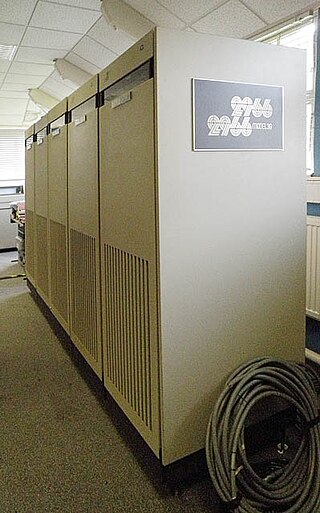
A computer program is a sequence or set of instructions in a programming language for a computer to execute. It is one component of software, which also includes documentation and other intangible components.
A monolithic kernel is an operating system architecture where the entire operating system is working in kernel space. The monolithic model differs from other operating system architectures in that it alone defines a high-level virtual interface over computer hardware. A set of primitives or system calls implement all operating system services such as process management, concurrency, and memory management. Device drivers can be added to the kernel as modules.

An operating system (OS) is system software that manages computer hardware and software resources, and provides common services for computer programs.
OS-9 is a family of real-time, process-based, multitasking, multi-user operating systems, developed in the 1980s, originally by Microware Systems Corporation for the Motorola 6809 microprocessor. It was purchased by Radisys Corp in 2001, and was purchased again in 2013 by its current owner Microware LP.

An embedded system is a computer system—a combination of a computer processor, computer memory, and input/output peripheral devices—that has a dedicated function within a larger mechanical or electronic system. It is embedded as part of a complete device often including electrical or electronic hardware and mechanical parts. Because an embedded system typically controls physical operations of the machine that it is embedded within, it often has real-time computing constraints. Embedded systems control many devices in common use. In 2009, it was estimated that ninety-eight percent of all microprocessors manufactured were used in embedded systems.
Direct memory access (DMA) is a feature of computer systems that allows certain hardware subsystems to access main system memory independently of the central processing unit (CPU).

In computing, an expansion card is a printed circuit board that can be inserted into an electrical connector, or expansion slot on a computer's motherboard to add functionality to a computer system. Sometimes the design of the computer's case and motherboard involves placing most of these slots onto a separate, removable card. Typically such cards are referred to as a riser card in part because they project upward from the board and allow expansion cards to be placed above and parallel to the motherboard.
The Internetworking Operating System (IOS) is a family of proprietary network operating systems used on several router and network switch models manufactured by Cisco Systems. The system is a package of routing, switching, internetworking, and telecommunications functions integrated into a multitasking operating system. Although the IOS code base includes a cooperative multitasking kernel, most IOS features have been ported to other kernels, such as Linux and QNX, for use in Cisco products.

A network interface controller is a computer hardware component that connects a computer to a computer network.
Memory-mapped I/O (MMIO) and port-mapped I/O (PMIO) are two complementary methods of performing input/output (I/O) between the central processing unit (CPU) and peripheral devices in a computer. An alternative approach is using dedicated I/O processors, commonly known as channels on mainframe computers, which execute their own instructions.
RTLinux is a hard realtime real-time operating system (RTOS) microkernel that runs the entire Linux operating system as a fully preemptive process. The hard real-time property makes it possible to control robots, data acquisition systems, manufacturing plants, and other time-sensitive instruments and machines from RTLinux applications. The design was patented. Despite the similar name, it is not related to the Real-Time Linux project of the Linux Foundation.
In computing, an interface is a shared boundary across which two or more separate components of a computer system exchange information. The exchange can be between software, computer hardware, peripheral devices, humans, and combinations of these. Some computer hardware devices, such as a touchscreen, can both send and receive data through the interface, while others such as a mouse or microphone may only provide an interface to send data to a given system.
In computer security, mandatory access control (MAC) refers to a type of access control by which the operating system or database constrains the ability of a subject or initiator to access or generally perform some sort of operation on an object or target. In the case of operating systems, a subject is usually a process or thread; objects are constructs such as files, directories, TCP/UDP ports, shared memory segments, IO devices, etc. Subjects and objects each have a set of security attributes. Whenever a subject attempts to access an object, an authorization rule enforced by the operating system kernel examines these security attributes and decides whether the access can take place. Any operation by any subject on any object is tested against the set of authorization rules to determine if the operation is allowed. A database management system, in its access control mechanism, can also apply mandatory access control; in this case, the objects are tables, views, procedures, etc.

The architecture of Windows NT, a line of operating systems produced and sold by Microsoft, is a layered design that consists of two main components, user mode and kernel mode. It is a preemptive, reentrant multitasking operating system, which has been designed to work with uniprocessor and symmetrical multiprocessor (SMP)-based computers. To process input/output (I/O) requests, it uses packet-driven I/O, which utilizes I/O request packets (IRPs) and asynchronous I/O. Starting with Windows XP, Microsoft began making 64-bit versions of Windows available; before this, there were only 32-bit versions of these operating systems.

K-202 was a 16-bit minicomputer, created by a team led by Polish scientist Jacek Karpiński between 1970–1973 in cooperation with British companies Data-Loop and M.B. Metals. The machine could perform about 1 million instructions per second, making it highly competitive with the US Data General SuperNOVA and UK CTL Modular One. Most other minicomputers of the era were significantly slower.

Nord-10 was a medium-sized general-purpose 16-bit minicomputer designed for multilingual time-sharing applications and for real-time multi-program systems, produced by Norsk Data. It was introduced in 1973. The later follow up model, Nord-10/S, introduced in 1975, introduced CPU cache, paging, and other miscellaneous improvements.

The ICL 2900 Series was a range of mainframe computer systems announced by the British manufacturer International Computers Limited on 9 October 1974. The company had started development under the name "New Range" immediately on its formation in 1968. The range was not designed to be compatible with any previous machines produced by the company, nor for compatibility with any competitor's machines: rather, it was conceived as a synthetic option, combining the best ideas available from a variety of sources.

The kernel is a computer program at the core of a computer's operating system and generally has complete control over everything in the system. The kernel is also responsible for preventing and mitigating conflicts between different processes. It is the portion of the operating system code that is always resident in memory and facilitates interactions between hardware and software components. A full kernel controls all hardware resources via device drivers, arbitrates conflicts between processes concerning such resources, and optimizes the utilization of common resources e.g. CPU & cache usage, file systems, and network sockets. On most systems, the kernel is one of the first programs loaded on startup. It handles the rest of startup as well as memory, peripherals, and input/output (I/O) requests from software, translating them into data-processing instructions for the central processing unit.
TurboDOS is a multi user CP/M like operating system for the Z80 and 8086 CPUs developed by Software 2000 Inc.

In computing, Linux-IO (LIO) Target is an open-source implementation of the SCSI target that has become the standard one included in the Linux kernel. Internally, LIO does not initiate sessions, but instead provides one or more Logical Unit Numbers (LUNs), waits for SCSI commands from a SCSI initiator, and performs required input/output data transfers. LIO supports common storage fabrics, including FCoE, Fibre Channel, IEEE 1394, iSCSI, iSCSI Extensions for RDMA (iSER), SCSI RDMA Protocol (SRP) and USB. It is included in most Linux distributions; native support for LIO in QEMU/KVM, libvirt, and OpenStack makes LIO also a storage option for cloud deployments.










